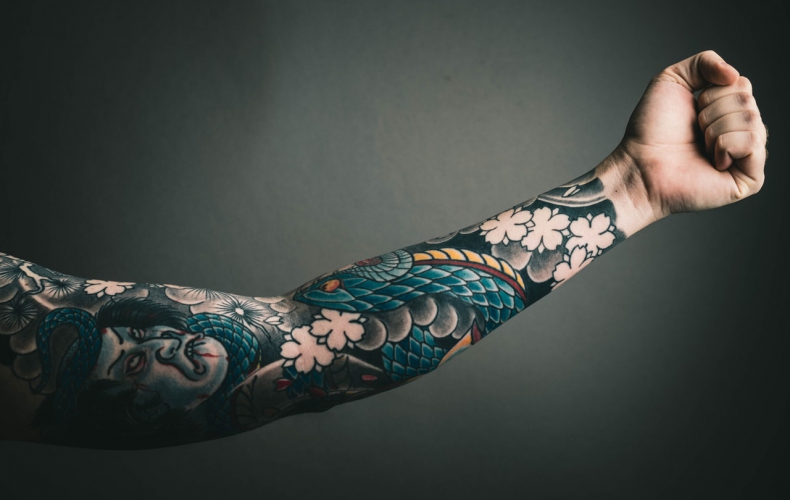Tattoo Copyright Explained – How to Protect Your Designs

It’s amazing how often businesses steal a tattoo design thinking it’s ripe for the taking! There is still little understanding that a tattoo constitutes the intellectual property of a tattoo artist or studio, and infringement occurs all the time – including several high-profile cases.
This article takes a look at examples of copyright infringement lawsuits, along with advice on how to protect yourself and your IP.
Examples of lawsuits involving tattoo copyright infringement
1. Restaurant chain uses tattoo design in branding and merch without consent
Tattoo artist Roger Ladoucer sued restaurant chain Macado’s Inc. after he discovered that a tattoo he designed of Frankenstein wearing a monocle was being used for promotional purposes. The tattoo was designed for one of Ladoucer’s clients and then used very publically to promote his own tattoo studio.
Thankfully this case was very cut and dry. Ladoucer’s lawsuit led to a settlement out of court in which the restaurant agreed to license the image and provided compensation for profits generated while they used the image illegally.
2. Video game company faces lawsuit over inclusion of LeBron James’ tattoo in NBA 2K
Tattoo artist Jimmy Hayden sued video game company Take-Two Interactive in 2017 over their inclusion of digital representations of his tattoo designs in the NBA 2K franchise. Hayden’s work is highly sought by NBA players, and his portfolio includes ink for LeBron James, Tristan Thompson, and Danny Green. Take-Two included those distinctive tattoos when designing the character models for those players in-game.
The case took a while to get off the ground and is still ongoing as of 2019, but the court has ruled that Hayden can sue for statutory damages. It is worth noting though that he is only allowed to include copyright violations for the NBA 2K17 game an onward as he only filed copyrights for his designs in 2016 after NBA 2K16 came out.
3. The Hangover Part 2 faces lawsuit over the use of Mike Tyson’s tattoo design
The year was 2011, and not everyone was looking forward to the upcoming sequel to The Hangover. Tattoo artist S. Victor Whitmill was agog when he saw Ed Helms’ character in the trailer for The Hangover Part 2 awkwardly inked with the distinctive face tattoo Whitmill designed for Mike Tyson. The tattoo design was subject to copyright.
He promptly sued Warner Bros. and attempted to stop the launch of the film. Days before the film was set to release, however, the U.S. District Court denied his request. The case went on, however, and when it was clear that the law was on Whitmill’s side, Warner Bros. settled with him out of court.
How can tattoo artists protect their copyright?
The Copyright Act of 1976 provides grounds for a lawsuit for artists that can prove:
- their creation is the type of work that is protectable under the Act,
- the creation is an original and creative work, and
- the creation is affixed to a tangible medium for expression.
The first two points are pretty cut and dry, provided the tattoo design is distinctly original. The third point, however, is still a bit dodgy with the courts. The medium for tattoos is a person’s skin, and it is legally implied to be able to photograph or record that person without issue.
While tattoo artists have successfully won lawsuits to protect their IP, it is still up in the air if the reproduction of a tattoo is or is not considered fair use. As of now, no tattoo copyright infringement case has been taken to Federal Court. It’s worth noting that in the case against Take-Two, LeBron James has actually sided with the video game company, as the tattoos are a part of his visible identity. Regardless, many celebrities now enter agreements with their tattoo artists so that there is never a legal issue surrounding the reproduction of their tattoo in the media.
As a tattoo artist it is important to protect your work, and making sure you go through the correct legal channels ensures a quick turnaround on any infringement issues. Designs that are sufficiently unique should be registered for copyright, and your tattoo consent and release form should cover IP ownership.
Making sure your tattoo consent and release form covers IP ownership
Filing for copyright is your best defense for IP infringement, but including a related clause in your tattoo consent and release form provides an additional defense. Here is an example:
I release all rights to any photographs taken of me and the tattoo and give consent in advance to their reproduction in print or electronic form.
By signing off on this agreement, the client is given explicit notice that the tattoo design is the property of the artist or studio. Since laws vary between countries and states/provinces, it’s important to make sure that your tattoo waiver form is examined by a lawyer.
It is also your responsibility to make sure that your waivers are filed securely and easy to find should a legal dispute come up. Using an online waiver solution allows you to store digital waivers both in the cloud and on an offline backup so they’re easy to find.
Your work is your livelihood and reputation – so make sure you take all the necessary steps to protect it!